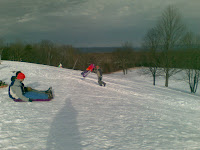
LAST WEEK'S ISSUE OF TIME had a very readable article on the problems of water use and availability ("Dying For A Drink"). The picture, from that article, is of Lake Mead. In 1995, when I was living in Arizona, this reservoir was full and now is nearing empty.
I have included the Web reference this in my most recent email to you. I also recommend three books:
Of course, I will be amazed if you all read all of the above. At least check out the Time article. With all that is going on...the world economies in recession, dwindling savings, the venality of politicians, and worse than useless waging of wars...I hesitate to urge you to read more bad news. Here in the US, it is clear that the next President will have his hands more than full. What can we do as individuals, we might well wonder?
It is really hard to know. As an example, would I buy the new plug in Volt when it becomes available? Oh well, most of you know I am more likely to stay with my 1991 Infiniti G20 which (it at 293,000 miles and I at 71 years) bids fair to outlast me and be my last motor car! Going with the argument...this car will be a "plug in" which means that you can recharge is at night and not spend a cent on fuel so long as you do not exceed the 40 miles battery capacity. Sixty percent of driving in the US has to do with getting to work and back and many will not exceed the 40 miles per day this car promises. Charging up a night will suit the power utilities as this will be 'off peak' power, at least for a while until millions of cars are recharging at night. Wind power will help as more and more wind farms are commissioned, and assuming that the power transmission grids will have been enlarged to take this additional quantity of power.
But consider that burning coal is environmentally dirtier than burning gasoline and, for the foreseeable future, there is no such thing as 'clean coal'. Also, until vast improvements are made in efficiency of cooling at electrical power generating plants, it will take more water to produce that power than is involved in producing the gasoline for the same energy. If we follow T. Boone Pickens Plan, we will exchange natural gas for coal, for cars and for electrical generation as an intermediate step while alternate energy production is developed.
It looks like that what you loose on the roundabouts you pick up on the swings, as the saying goes.
I consider that totally 'plug in' cars will be a huge environmental miscalculation and maybe the Pickens Plan has a lot going for it. Running cars on compressed natural gas is certainly practical as Australia has shown (where you can fill up on liquefied natural gas at most service stations and where you can buy a new car converted to run on this fuel). Notice the link between the fuel you choose and the amount of water needed to produce that fuel. In the case of ethanol from corn that is about four gallons of water for one gallon of ethanol (not including the water needed to produce the fertilizer and the fuels for growing the corn).
Maybe we are learning the value of conservation and moderation. US motorists are driving less and driving more slowly (or were, until gasoline prices fell to current levels...I bought gas at $1.75 the other day). Consequently we are using less fuel overall and our 'persons per million miles killed' has fallen to the lowest rate in years. High efficiency lighting and slower better thought out driving can go a long way, it seems, in conserving energy. As to what to do about profligate water use, who knows what will bring us to our senses?
Last of all, two bons mots from famous Americans:
"When the well's dry we know the worth of water." -- Ben Franklin
"Whiskey is for drinking and water is for fighting over." -- Mark Twain



.jpg)

















